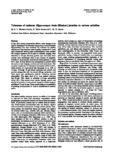Tolerance of seahorse Hippocampus kuda (Bleeker) juveniles to various salinities
Share
Abstract
In line with current conservation efforts, some success in the captive breeding of the seahorse Hippocampus kuda (Teleostei: Syngnathidae) has been achieved. To evaluate the salinity tolerance of these hatchery-bred juveniles, 9-week-old H. kuda were transferred without prior acclimatization from ambient full strength seawater (32–33 ppt) to salinities ranging from freshwater to 85 ppt. Survival, growth, and total body water content were determined after 4 and 18 days of exposure. Juvenile H. kuda are able to survive in dilute seawater (15 ppt) for at least 18 days without any compromise in growth (both wet and dry body weight), survival, and total body water. Fish abruptly transferred to freshwater succumbed within 4–24 h, while survival of 5 ppt-reared fish decreased to ca. 65% in 18 days. Although 10 ppt-reared seahorses had growth and survival comparable with the control (30 ppt seawater), total body water was significantly elevated indicating reduced adaptability. The upper limit of H. kuda salinity tolerance was 50 ppt. Fish reared at salinities ≥55 ppt succumbed within 24 h. Like several other marine teleosts, growth and survival of juvenile H. kuda tended to peak in diluted seawater salinities of 15 and 20 ppt. These results indicate the possibility of growing hatchery-bred H. kuda in brackishwater environments.
Suggested Citation
Hilomen-Garcia, G. V., Delos Reyes, R., & Garcia, C. M. H. (2003). Tolerance of seahorse Hippocampus kuda (Bleeker) juveniles to various salinities. Journal of Applied Ichthyology , 19(2), 94-98. https://doi.org/10.1046/j.1439-0426.2003.00357.x
Subject
Taxonomic term
Collections
- AQD Journal Articles [1248]

